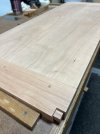I have made many breadboard ends over the years on Greene and Greene style pieces including dining tables, benches, sideboards, etc., so I have a lot of experience with this construction. All of the above noted methods, multiple dowels, stopped spline, dominoes, deep tongue and groove, et al., will work, gluing only in the middle 3-4 inches. Are the breadboard ends going to be supported from underneath, or will they overhang the underlying cabinet? If they overhang, then they will need to be attached with longer tenons or dowels to provide resistance to any bending force, like a person leaning on them. Also, in accommodating for the wood movement that will occur, the breadboard end should be just a bit longer than the width of the top, especially if you make it during the winter when the moisture content will be the lowest. If you make it the exact width of the counter, when the counter expands during the summer, there will be a step off because the counter will be wider than the end, and that doesn't look very good. The reverse situation, with the breadboard end being longer, the look is more pleasing, and becomes a subtle part of the design. The movement is not going to be much, as it looks like many of the pieces in the top are quartered or rift sawn, and these won't move much at all. Making the breadboard overhang on each side 1/16"-1/8" would be quite sufficient.
Whatever method you ultimately decide upon, it is critical that you have a reliable means of registering all of your dadoes, holes, mortises, etc. on both sides of the joint. If you are going to use dowels, I think a doweling jig is an absolute must. Measuring, marking, and drilling holes for multiple dowels, and getting them all lined up accurately without a doweling jig is nearly impossible in my experience. Finally, the joint along the width of the counter where the two pieces meet tends to move very slightly across the thickness of the pieces. If you make it absolutely level by planing, scraping, or sanding so that it is absolutely flat, eventually you will feel, or perhaps even see, a very slight step off along the joint. There are a couple of solutions to this problem that I have used. You can make the breadboard slightly thicker, so that it's upper surface is slightly above the main counter, putting a 45 degree chamfer on the upper edge. If you don't want the end to be thicker, then you can make a slight chamfer on both the breadboard and the top, resulting in a shallow V groove running along the width of the top. This has the effect of accentuating the joint, creating a visual and tactile line that becomes part of the design.
I hope some of this helps. Good luck with whatever method you choose, and keep us informed of your progress and the final result.
Matt



